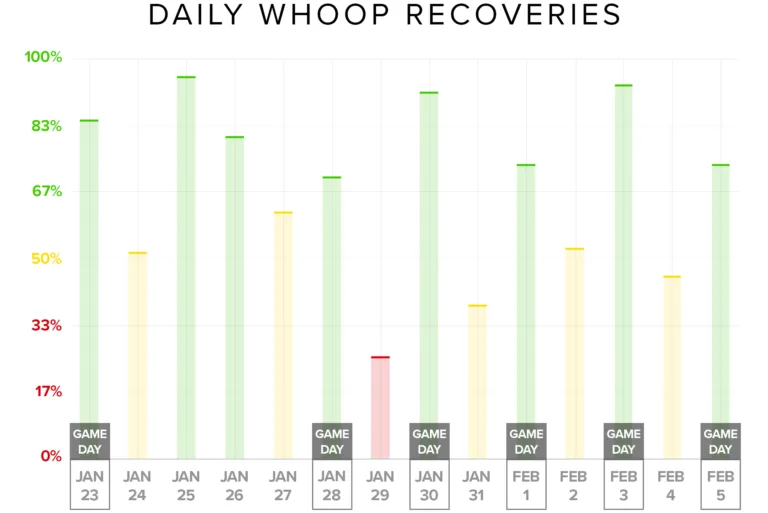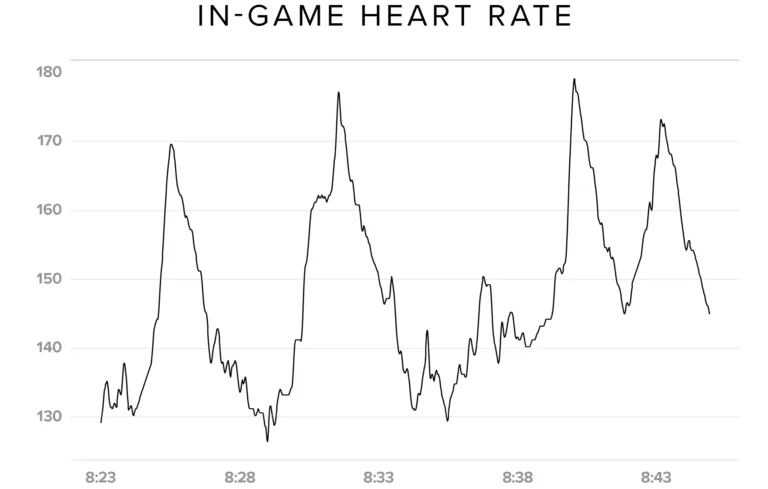Topics
- Article
- Hockey
- Member Stories
Stanley Cup Champ Alex Killorn Shares Heart Rate, Strain, Sleep & Recovery from Title-Winning Season

What do pro hockey players’ heart rates look like during a game? How do their schedules impact sleep and recovery throughout the season? And what kind of added strain do they take on in the playoffs?
With the NHL season beginning tonight, we take a look at the WHOOP data of one of our longest-tenured members, Tampa Bay Lightning center and two-time defending Stanley Cup champion Alex Killorn. We answer all the above questions and more, examining his sleep, recovery, strain, and other heart rate metrics during Tampa’s title run, as well as the potential impact they had on his success.
Season Highs in Sleep, Recovery, HRV & Strain
Spanning the entire 2020-2021 regular season and playoffs, here are Killorn’s top numbers for several key WHOOP metrics.

Alex Killorn's highest sleep, recovery, strain, and HRV numbers from the 2020-2021 season.
To no surprise, many of these stats have direct correlations to standout performances on the ice. In the next game following his longest night of sleep (8:45 on May 31), Killorn scored a goal in a 2-1 second-round playoff victory over Carolina. His highest heart rate variability (HRV) of the season came on March 18. He scored that night and was +1 in a 4-2 win vs Chicago (it was also the day he had his lowest/best resting heart rate of the year, 43 beats per minute). Killorn’s most strenuous day of the year (a 20.5 strain on a 0-21 scale) was June 25, when he assisted on the lone goal in a 1-0 Game 7 victory over New York in the Eastern Conference Finals. It's no coincidence that was likely the biggest and most intense and stressful game he played in all season. “This past year I realized how much WHOOP can help me figure things out throughout a season,” he told us. “I wore it every single game.”
Improving Sleep and Recovery on Game Days
Below you can see Killorn’s averages for a variety of key WHOOP stats on days he had games compared to days he did not. He spent more time in bed and got more sleep prior to game days (as well as a higher percentage of restorative REM sleep), and also saw an increase in heart rate variability and a decrease in resting heart rate.

Killorn posted significantly better WHOOP metrics on game days than he did on off days.
“For me, it’s all about sleep and recovery,” Killorn said. “The more time in bed the better. If my sleep numbers are better my [WHOOP] recovery is typically better too. When we play every other day, my recovery after games is almost never in the green, it’s typically in the yellow. But every day before a game it’s [back] in the green. It typically just goes green-yellow, green-yellow.” Here’s a two-week sample of his recovery data that illustrates Killorn’s point.

Killorn's WHOOP recoveries are regularly green prior to games, then take a hit the day after.
Given the high strain of game days (average of 18.1), it makes sense that his recovery tends to dip immediately afterwards. However, it’s quite impressive that Killorn is regularly able to bounce back into the green a day later. “A lot of times we’ll have optional skates, and [whether I do them or not] will be based on my recovery scores,” he explained. “You obviously want to go out there and improve and work on things, but if my recovery wasn’t great I probably took the optional skates off.” In addition to decreasing the workload on his body, some of Killorn’s other techniques to benefit sleep and recovery include:
- Daily compression boot sessions of about 20 minutes
- Naps for 60-80 minutes in the afternoon before games
- Saunas followed by cold plunges
- Meditation
- Post-game rub downs, “a flushing to get the lactic acid out”
- Blue-light blocking glasses before bed
- Sleeping in a cool room with temperature set at 68 degrees
“The night before every single game I’ll do an Epsom salt bath,” he added. “I’ll meditate while I do it to kill two birds with one stone. When we travel I always have to get a tub in my room, I try to mimic home on the road. I also have a bag I bring with a noise cancelling machine, my own pillow, and a humidifier.”
Heart Rate During Games
During games, Killorn’s average heart rate is usually about 130 beats per minute (including the extended breaks between periods), with a max HR of just under 180 bpm. Looking at a sample of his in-game HR data, you can see how it distinctly rises and falls in short bursts around his shifts on the ice, which only last for about 40-45 seconds.

During games Killorn's heart rate often stays above 125 bpm the entire time, and spikes to around 180 bpm when he's on the ice.
Even when he’s “resting” on the bench, Killorn’s heart rate rarely falls below 125 bpm.
Taking It to the Next Level in the Playoffs
When the postseason began, Killorn doubled down on doing everything he could to boost his sleep and recovery. “In the playoffs we practice a lot less often,” he said. “And when we do it’s usually just a pre-game skate, because rest is so important. You’re not going to really learn anything new or improve on anything system-wise at that point, you want guys to be well rested.” Killorn elevated his sleep consistency (going to bed and waking up at similar times) from 66% in the regular season to 69% in the playoffs, and upped his daily recovery average 9%. With the intensity of competition heightening as well, his average strain on game days also increased from 17.9 to 18.8. “During the playoffs I got a rub down before every game too,” he noted. “I have a sauna in my home and I did the sauna a lot more in the playoffs. I had the best playoffs of my career.” The extra efforts Killorn put in clearly paid off, as his best statistical games of the year came in the postseason. On May 22, he had a pair of goals and assists in a 6-2 win over Florida, his highest point total (4) of the season. The night before he slept 35 minutes more than his game-day average, and his HRV and RHR were both significantly better than the norm as well. All of this led to a 91% recovery, a great indication that his body was primed to perform.

Killorn's best game of the year came when his WHOOP stats suggested his body was in great shape to perform.
A few weeks later, Killorn again scored twice and added an assist as his team beat New York 8-0 on June 21. His big game followed a great night of high-quality sleep, consisting of 34% REM and 26% deep sleep (compared to game-day averages of 30% and 23% respectively), as well as fewer disturbances than usual (14 vs. 17).
Heart Rate While Breaking His Leg in Finals
Killorn suffered an unfortunate season-ending injury in Game 1 of the Stanley Cup Final. “I blocked a shot and broke my fibula,” he said. “I played with a broken fibula for three more shifts, but then I couldn’t play any more.” Below you can see the spike in his heart rate just as the injury occurred.

Killorn's heart rate shot up immediately after blocking a shot and breaking his leg.
Despite skating on a broken leg for several more minutes, Killorn’s heart rate actually remained within its typical range for the rest of his time on the ice. As might be expected, he slept terribly that night (only 4:57), and his recovery the next day was just 21%. Eight days later Killorn’s recovery dropped even lower to 4%, although we’re guessing there may have been some other factors involved--his team had just won its second straight Stanley Cup.